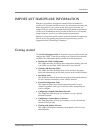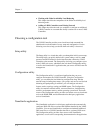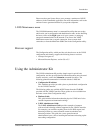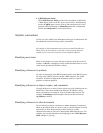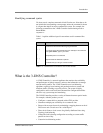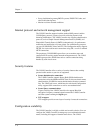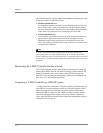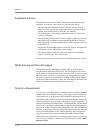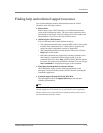
Introduction
3-DNS
®
Administrator Guide 1 - 7
Controller supports a variety of media options, including Fast Ethernet, and
Gigabit Ethernet; the 3-DNS Controller also supports multiple network
interface cards that can provide redundant or alternate paths to the network.
Note
If you use NameSurfer to manage your DNS zone files, you can configure
only up to 100 IP addresses and domain names.
System synchronization options
The 3-DNS Controller sync group feature allows you to automatically
synchronize configurations from one 3-DNS Controller to any other 3-DNS
Controller in the network, simplifying administrative management. The
synchronization feature offers a high degree of administrative control. For
example, you can set the 3-DNS Controller to synchronize a specific
configuration file set, and you can also set which 3-DNS Controllers in the
network receive the synchronized information and which ones do not.
Configuring data collection for server status and network path data
The 3-DNS platform includes the big3d agent, which is an integral part of
3-DNS load balancing. The big3d agent continually monitors the
availability of the servers that the 3-DNS Controller load balances. It also
monitors the integrity of the network paths between the servers that host the
domain, and the various local DNS servers that attempt to connect to the
domain. The big3d agent runs on any of the following platforms: 3-DNS
Controller, BIG-IP systems, EDGE-FX Cache, and GLOBAL-SITE
Controller. Each big3d agent broadcasts its collected data to all of the
3-DNS Controllers in your network, ensuring that all 3-DNS Controllers
work with the latest information.
The big3d agent offers a variety of configuration options that allow you to
choose the data collection methods you want to use. For example, you can
configure the big3d agent to track the number of router hops (intermediate
system transitions) along a given network path, and you can also set the
big3d agent to collect host server performance information using the SNMP
protocol. For further details on the big3d agent, refer to the 3-DNS
Reference Guide, Chapter 5, Probing and Metrics Collection.
Redundant system configurations
A redundant system is essentially a pair of 3-DNS units, with one operating
as the active unit that responds to DNS queries, and the other one operating
as the standby unit. If the active unit fails, the standby unit takes over and
begins to respond to DNS queries while the other 3-DNS unit restarts and
becomes the standby unit.





